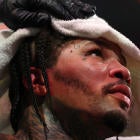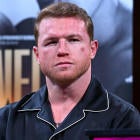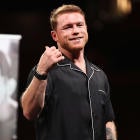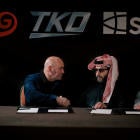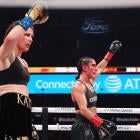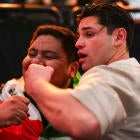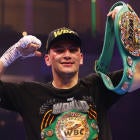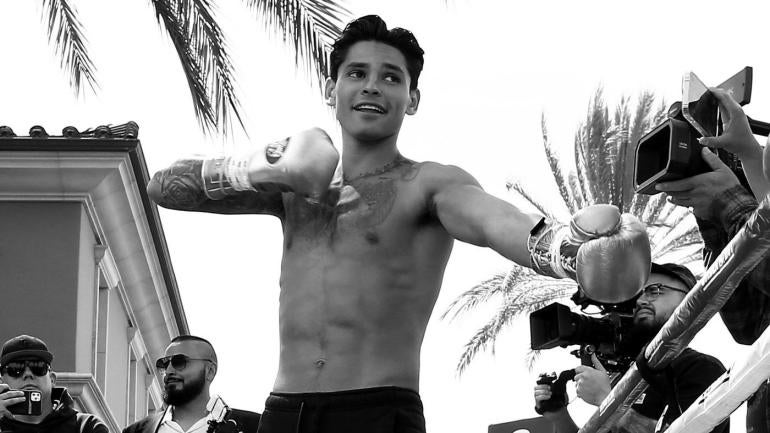
If there was a single moment when Oscar De La Hoya, the Hall-of-Fame boxer and promoter of lightweight superstar "King" Ryan Garcia, was first convinced his fighter was destined for greatness, it came two years ago against Luke Campbell.
Garcia, then just 22, was dropped hard by a clean left hand in Round 2 yet rose from the canvas to finish Campbell in Round 7 with a body shot that sent the former Olympic gold medalist into retirement at age 33.
"It's the way he recuperated and got back up, I saw that fire in his eye," De La Hoya told "Morning Kombat" on Monday. "It's very rare in boxing. You either get dropped and you fold or you come back up and you fight harder than ever with fire in your eyes. That's exactly what I saw in Ryan."
For all of the whispers from his critics about Garcia (23-0, 19 KOs) having no chin or that his wild popularity (which includes 9.5 million Instagram followers) means he's more pretty boy than real fighter, the native of Victorville, California, proved them wrong by his actions, just as his promoter once did in a career-defining victory over Ike Quartey some two decades ago.
On the surface, Garcia represents everything that's new about the modern-day boxing icon. He's as handsome as he is confident, having built his massive following -- which leans young, female and atypical of the traditional fight fan -- almost exclusively on social media. Yet his decision to risk it all on Saturday so early in his career as the betting underdog against Gervonta "Tank" Davis (28-0, 26 KOs) at T-Mobile Arena in Las Vegas (Showtime PPV, 8 p.m. ET) is as old school as it gets.
Can't get enough boxing and MMA? Get the latest in the world of combat sports from two of the best in the business. Subscribe to Morning Kombat with Luke Thomas and Brian Campbell for the best analysis and in-depth news.
To be fair, the 28-year-old Davis, a southpaw knockout machine from Baltimore whose technical boxing ability has drawn pound-for-pound acclaim, deserves an equal helping of praise for willingly seeking such a dangerous test rather than waiting years for the fan's interest (and the piles of money that accompany it) to reach a fever pitch. If it truly takes two to tango in the frustrating world of boxing negotiations that cross promotional and network lines, Davis was game throughout the difficult process.
"It's not about the money no more, it's about showing these guys they ain't really like that," Davis told CBS Sports following a March press conference in New York to announce the fight. "Guys that want my spot, I'm here to stay. That's what it is."
But the more those with knowledge of the negotiations ahead of this decidedly unique superfight speak out, they tend to echo the same sentiment.
"I believe Ryan Garcia is the real reason that this fight is being made," De La Hoya said.
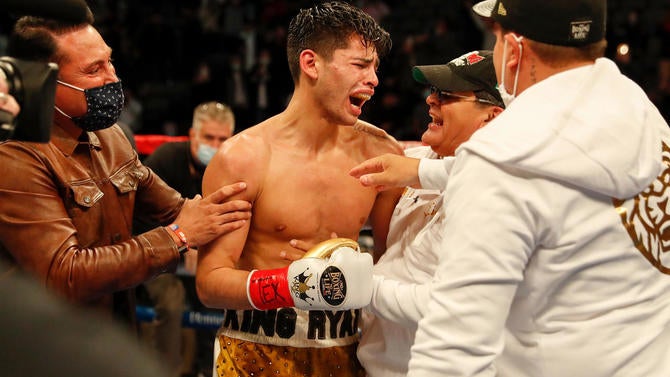
How we got here
Even though it's refreshing that most of the story of how Davis-Garcia was made goes against modern practices and stereotypes, this is anything but "the fight to save boxing."
That infamous tagline was once ascribed on a "Sports Illustrated" cover to De La Hoya's record-shattering superfight with Floyd Mayweather, which owes comparisons to Davis-Garcia only in the sense that the two fighters headlining that 2007 pay-per-view event hold varying levels of promotional control today over their much younger counterparts. (Mayweather Promotions, which formally represented Davis, now works in association with his GTD Promotions, alongside Premier Boxing Champions and TGB Promotions.)
Calvin Ford, the trainer of Davis, prefers to classify the event as "the Generation Z fight," saying that to the fighters and their respective younger fan bases, "this is their Oscar-Floyd, right now." De La Hoya, meanwhile, called it "the fight to grow boxing," given its crossover potential.
For Stephen Espinoza, the president of Showtime Sports, Davis-Garcia is unique all unto itself.
"I think it's completely accurate to call this the first social media superfight," Espinoza told CBS Sports this week. "That doesn't mean that prior fights haven't relied on social media marketing or didn't have major social media stars. The most obvious of which is Floyd Mayweather, who built a lot of his fanbase through social media. What I mean is that for the first time, social media is front and center and it's organic to this fight and how these two fighters very intentionally built their fanbases and how they engage with their fans on a daily basis.
"This is one where you go where the fan base and customer is."
Although Davis doesn't enjoy the same social media following as Garcia, he's certainly the bigger star within boxing as a consistent PPV draw who has sold out arenas in multiple major U.S. cities. He also attracts a large celebrity clientele across entertainment and pro sports due to his "it factor" as a colorfully tattooed slugger whose consistent legal troubles have kept him in the headlines between fights (and could land him in prison at a scheduled May 5 sentencing hearing after a guilty plea to hit-and-run charges).
For any hardcore boxing fan, the true beauty of this event is that it actually came off at all. During the same calendar year when similar superfights like Errol Spence Jr. vs. Terence Crawford and Tyson Fury vs. Oleksandr Usyk keep falling apart, Davis-Garcia is a unicorn.
It's not just the combined age and records of the fighters, or that they both employ similarly exciting styles that has led to 45 knockouts in a combined 51 wins between them. Superfights in boxing are either not made at all or pushed back multiple years (often past their freshness date) because of a frustrating confluence of realities that extend far beyond the simple concept of fighters wanting to take on difficult challenges and test themselves.
History will be made 🔥 #DavisGarcia LIVE on PPV: https://t.co/HONDZDXW5g pic.twitter.com/OIUvF5ylRb
— SHOWTIME Boxing (@ShowtimeBoxing) April 18, 2023
"It becomes more complicated when you factor in the business objectives of the fighters, promoters and networks," Espinoza said. "You have exclusive relationships with networks, promotional rivalries and sanctioning bodies, which may or not be complying with mandatories or voluntaries. They are all important pieces of the mosaic of the boxing business but each comes with their own sort of complications which often makes these fights more complicated than we expect."
Even though the initial idea of the fight seemed to be birthed after Garcia's breakthrough win over Campbell, and the ensuing social media trash talk that followed (including an explosive interaction over FaceTime while Garcia was on the "Hotboxin' with Mike Tyson" podcast), few in the game felt there was a reality of it happening anytime soon.
Not only did Garcia never quite capitalize on the initial buzz of the Campbell win when subsequent wrist surgery and a mental health scare kept him idle for 16 months, the reality of each fighter being tied exclusively with their respective networks (Garcia on DAZN and Davis on Showtime) trumped the already difficult task of getting De La Hoya's Golden Boy Promotions to resuscitate its business connections with PBC founder Al Haymon after a bitter 2014 divorce.
Although there has been selective history of major networks joining forces for one-off superfights over the past two decades (from Lennox Lewis vs. Mike Tyson in 2002 to Tyson Fury vs. Deontay Wilder III in 2021), DAZN arrived on the scene in 2018 as a boxing disrupter and streaming service designed, as their initial marketing catchphrase said, "to kill PPV," which didn't quite scream the prospects of future collaboration to further the overall health of the sport.
"We have probably been part of the problem, historically, given our exclusive relationships with fighters, but as we have gotten more mature in the boxing business as a broadcaster, we recognize that we have a responsibility to invest in covering the full sport and finding big ways to make fights happen," DAZN executive vice president Joe Markowski told "The MMA Hour" in March.
"This is a unique problem in boxing and I think we made a statement publicly that we want to try and be part of the solution. I think if boxing doesn't do this, it risks becoming less relevant because there is nothing that is going to turn fans off [more than] big events not happening."
Even with Showtime reportedly unwilling to co-produce the PPV with DAZN under a traditional two-network agreement, something De La Hoya described as "a big hurdle," cooler heads somehow prevailed throughout the seven-month negotiation. Not just because of the internal push from Garcia to Golden Boy, but also because of DAZN's agreement to distribute the Showtime-produced broadcast and help market the event in exchange for financial benefits.
"There's no real rhyme or reason or logic to the structure we ended up on," Espinoza said. "It's very much a split-the-baby result. It's not perfect or precisely what everybody probably wanted in their ideal picture of how this played out, but it's something everyone could live with to allow the fight to go forward. There are a lot of reasons why various partners go into a deal looking for what they can get out of it. In this situation, each side came to the table with what they needed."
Markowski said DAZN felt separate broadcast feeds were simply inefficient while pointing out how comfortable they were with the job Showtime does on production. He also mentioned the benefit of having "big mouthpieces" across both platforms talking up the same fight on various broadcasts and podcasts rather than trying to ignore it or counter program against it.
"When you have those ingredients, that's what you need for boxing to cut through the noise and to reach as many households in the U.S. as possible," Markowski said. "I think there are few fights in the U.S. that have the potential to do seven-figure pay-per-view buys. This is definitely one of them. We are going to play our part in making that happen."
Despite the harmonious result, De La Hoya described negotiations between both Showtime and DAZN, as well as Golden Boy and PBC, as being a bumpy ride with every small detail debated.
"We had to go literally territory by territory to see who was going to get what, across the globe," De La Hoya said. "At one point, this fight was actually dead in the water. I remember calling my personal lawyer to reach out to Stephen Espinoza, who used to work in the same firm. We revived it. We talked some sense and we were able to make this fight happen."
De La Hoya credited the rekindling of his business relationship with Espinoza, who formerly served as both his personal lawyer and chief legal representation for Golden Boy before coming to Showtime in 2012, as a major reason -- if not, the reason -- the deal survived various hurdles. It's a revelation contested by multiple sources, each of whom sought anonymity and claimed De La Hoya's role in the negotiation was very minor compared to that of Garcia advisor Guadalupe Valencia.
Espinoza, who cited his ability to have candid conversations with De La Hoya as something that "cut through the attempts to make leverage and positioning" from those with the power to do so, ultimately cited Davis and Garcia as the real reason the fight is happening.
"When you have the two fighters refusing to entertain other opportunities, everyone is sort of forced to make the deal no matter how long it takes," Espinoza said. "No matter what other naysayers were saying publicly or privately, Tank and Ryan were committed to get this fight done and never lost focus. That was the key."
For as much as Davis-Garcia is only happening because the fighters made sure not to entertain a Plan B, one fighter was forced to clear more hurdles in order to make this dream a reality.
.@Gervontaa and @RyanGarcia's dance with destiny is almost here ⏳ #DavisGarcia Saturday on PPV: https://t.co/uwVCxBtFNj pic.twitter.com/EwZiN0fH3l
— SHOWTIME Boxing (@ShowtimeBoxing) April 20, 2023
Garcia concedes in pursuit of greatness
In a star-studded matchup like Davis-Garcia, both fighters come to the negotiation table feeling like the alpha. But as modern history has taught us, the one who is able to exercise the higher level of leverage becomes the de facto A-side of the PPV and can demand non-negotiable terms.
No major superstar has been immune from utilizing such advantages whether the desire is rooted in pettiness or necessity. Whether it's the brand of gloves, the split of the purse or the contracted weight, everyone from Mayweather to Canelo Alvarez and, yes, even Davis have established unbreakable parameters.
That's how the game is played.
"I think it's less about imposing A-side privileges or taking a pound of flesh -- literally and figuratively -- from the B-side, as much as it is coming back to particular objectives," Espinoza said. "We saw a fight in March where [Caleb] Plant came in and had a very specific ask [to David Benavidez] about the size of the ring. That was simply his condition for participating. That was one of the factors that had to be met in order for him to become comfortable taking the fight."
Even De La Hoya, whose true legacy as an all-time great fighter has surrounded his willingness to always take on the most difficult challenge available to him, even made Bernard Hopkins come down two pounds for their 2004 undisputed middleweight title bout and forced Mayweather to take less money and come up a full division three years later.
In the case of Garcia, as the less experienced and accomplished of the two stars, he was forced to agree to a smaller cut of the fight purse along with allowing Showtime to take the broadcasting lead. But it was the additional asks from Davis and his team regarding weight that created another impasse.
"It was pretty unique in this situation because on one side I had Ryan Garcia open and vocal about making this fight and wanting it so, so bad," De La Hoya said. "On the other side, I was cringing because it's like showing your cards in a poker game. It was really difficult to negotiate. We literally had to give in on everything because Ryan Garcia wanted this fight so bad. And the other side obviously took advantage of that but luckily we came to terms."
Although Garcia hasn't made the 135-pound limit since the Campbell fight, and returned twice in 2022 at junior welterweight, Davis insisted that the fight be contested at lightweight. The only consolation came in the form of a one-pound allowance (and a negotiated catchweight of 136 pounds), which both sides agreed to.
"We wanted to make sure we could make the fight happen," Ford said. "Sometimes you have to do things that both teams will be agreeable with. Tank can make 135 but we wanted to make sure both sides would make the fight."
Isn’t it funny you only went up in weight at 140 to fight Mario but with me you didn’t, shows that you are not that confident and looking for any edge. Nothing going to save you remeber that. No edge can stop what’s already destined. https://t.co/8z2KgOrAtd
— RYAN GARCIA (@RyanGarcia) September 3, 2022
Even though Davis formerly moved up to 140 pounds to stop unbeaten Mario Barrios in 2021, Espinoza defended the decision.
"From the Tank side, the two fighters are built very differently. Ryan is much taller and has the ability, if he wanted to, in putting on a lot of weight," Espinoza said. "There are certain parameters that Tank's side needed in order to be comfortable taking the fight."
One of those parameters included a 10-pound rehydration limit between the Friday weigh-in and the fight, along with hefty fines for every pound either fighter would come in over the agreed upon rehydration limit of 146 pounds.
Not only did De La Hoya reveal the rehydration clause was almost a dealbreaker, he said he urged his fighter not to accept it. It's a topic Garcia was still sore about when he was quick to bring it up in March.
"[Davis] likes to fight people with no power so he's hoping to weight drain me," Garcia said. "There is a lot of stipulations in there that show what kind of character he has and his integrity. It shows what kind of will as a competitor he has. He doesn't have it. He doesn't have the heart of a champion.
"It's hard. I'm 24 and not a little guy anymore. I'm making a lot of sacrifices right now. I'm very hungry, very thirsty and I'm on a strict diet. I'm doing everything I have to do and making every sacrifice I can think of to make this fight happen."
Leonard Ellerbe, the CEO of Mayweather Promotions who has helped guide Davis' career, had a different theory as a longtime vocal detractor of De La Hoya as to why he advised Garcia to step away from the negotiations.
"It's never personal [with De La Hoya], it's just business and I was glad that Ryan made them do the fight," Ellerbe told "The MMA Hour" on Wednesday. "Let's be clear, this was not something that Oscar wanted him to do. I know that for a fact. Oscar is a smart guy as it relates to ring intelligence. The fight in the ring, I don't think he thinks that Ryan Garcia can win. It's just my opinion."
De La Hoya ultimately praised the true fighter within Garcia as the reason he accepted Davis' specific terms although it's clear his own rivalry with Mayweather remains fresh. In fact, "The Golden Boy" couldn't pass up one final dig at his former rival, who defeated De La Hoya via split decision in 2007, as the reason why Garcia is bucking a trend by risking his unbeaten record so early.
"When I was promoting Floyd -- I believe it was about 10 fights that Golden Boy put together for him -- the opponents that we chose were for that matter, to protect the 0," De La Hoya said. "That's no secret in the game. That's the exact reason why Mayweather was facing Juan Manuel Marquez [in 2009], a faded [Shane] Mosley [in 2010] and other fighters in his resume that kept him undefeated. There's no secret in that."
De La Hoya pointed to his own split-decision loss to a then-unbeaten Mosley in their first meeting in 2000, and the difficult decision he made to face a fighter many were avoiding, as the reason why Garcia is making the right decision in facing Davis and risking defeat.
"When you are in a great fight and you give it your all when facing the very best, there is no loser," De La Hoya said. "You actually come out winning, at the end of the day, if you put out your best performance. I always prided myself on putting my legacy first. That's what I tell every young fighter. There's a certain type of rush you feel when you are facing the best. You are gaining the respect of the fans and your peers and setting yourself apart from the rest.
"If you do that, the money will follow. If you are fighting the very best, you are going to be making the best purses out there. That's just the way it is. A lot of fighters these days try and think about the business first. No, think about your legacy first and the money will be there."
The pursuit of legacy is the exact reason why both fighters ultimately said yes. It's a refreshing and old-school quality that many hope, should the fight live up to its expectations both commercially and in terms of excitement, leads to a ripple effect across the sport.
For Garcia, it's also about standing up to the loud minority of doubters who have criticized his every move as a public figure by showing the world how great he can be.
"I think it's really a testament to where my heart truly is," Garcia said. "There have been a lot of perceptions of who I am as a fighter or if I'm serious about it. I was tired of the misconception about myself. I said to myself, 'I will do everything I have to do to make this fight happen.' I put the fans and the sport before myself because a lot of times during this negotiation, I probably should've said no because of the stipulations he put against me.
"I'm staying true to myself and not letting the business of boxing sway me from my morals or my character. My character is to fight the best. Yeah, I could've milked this a little bit more but then I'm going against myself.
"Does this start a trend? I don't know, it's just me being myself. But I can lead by example."
Who wins Gervonta Davis vs. Ryan Garcia? And which prop is a must-back? Visit SportsLine now to see Peter Kahn's best bets for Saturday, all from the boxing specialist who has netted his followers a profit of more than $4,000, and find out.
![[object Object] Logo](https://sportshub.cbsistatic.com/i/2020/04/22/e9ceb731-8b3f-4c60-98fe-090ab66a2997/screen-shot-2020-04-22-at-11-04-56-am.png)








